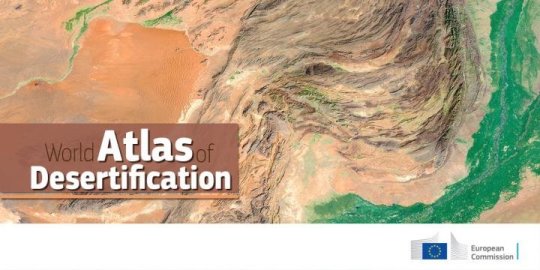[ad_1]
On 21 June 2018, the Joint Research Centre of the European Commission published a new edition of the World Atlas of Desertification, offering a tool for decision makers to improve local responses to soil loss and land degradation.
The Atlas provides the first comprehensive, evidence-based assessment of land degradation at a global level and highlights the urgency to adopt corrective measures.
Tibor Navracsics, Commissioner for Education, Culture, Youth and Sport, responsible for the Joint Research Centre (JRC), said: “Over the past twenty years, since the publication of the last edition of the World Atlas of Desertification, pressures on land and soil have increased dramatically. To preserve our planet for future generations, we urgently need to change the way we treat these precious resources. This new and much more advanced edition of the Atlas gives policymakers worldwide comprehensive and easily accessible insights into land degradation, its causes and potential remedies to tackle desertification and restoring degraded land.”
The Atlas provides examples of how human activity drives species to extinction, threatens food security, intensifies climate change and leads to people being displaced from their homes.
The main findings show that population growth and changes in our consumption patterns put unprecedented pressure on the planet’s natural resources:
- Over 75% of the Earth’s land area is already degraded, and over 90% could become degraded by 2050.
- Globally, a total area half of the size of the European Union (4.18 million km²) is degraded annually, with Africa and Asia being the most affected.
- The economic cost of soil degradation for the EU is estimated to be in the order of tens of billions of euros annually.
- Land degradation and climate change are estimated to lead to a reduction of global crop yields by about 10% by 2050. Most of this will occur in India, China and sub-Saharan Africa, where land degradation could halve crop production.
- As a consequence of accelerated deforestation it will become more difficult to mitigate the effects of climate change
- By 2050, up to 700 million people are estimated to have been displaced due to issues linked to scarce land resources. The figure could reach up to 10 billion by the end of this century.
While land degradation is a global problem, it takes place locally and requires local solutions. Greater commitment and more effective cooperation at the local level are necessary to stop land degradation and loss of biodiversity.
Further agricultural expansion, one of the main causes of land degradation, could be limited by increasing yields on existing farmland, shifting to plant-based diets, consuming animal proteins from sustainable sources and reducing food loss and waste.
The Atlas gives a clear overview of the underlying causes of degradation worldwide. It also contains a large number of facts, forecasts and global datasets that can be used to identify important biophysical and socio-economic processes that, on their own or combined, can lead to unsustainable land use and land degradation.
Background
Under the United Nations’ Sustainable Development Agenda, world leaders have committed to “combat desertification, restore degraded land and soil, including land affected by desertification, drought and floods, and strive to achieve a land degradation-neutral world” by 2030.
While at global level desertification is addressed by the United Nations Convention to Combat Desertification (UNCCD), land degradation is a problem that concerns the United Nations Framework Convention on Combating Climate Change and the Convention on Biodiversity.
The importance of land degradation and desertification led to the adoption of Sustainable Development Goal 15.3 aiming at land degradation neutrality.
At EU level desertification affects 8% of the territory, particularly in Southern, Eastern and Central Europe. These regions — representing around 14 million hectares — show high sensitivity to desertification.
Thirteen Member States have declared themselves affected by desertification under UNCCD: Bulgaria, Croatia, Cyprus, Greece, Hungary, Italy, Latvia, Malta, Portugal, Romania, Slovakia, Slovenia and Spain.
The EU is fully committed to protecting soil and fostering sustainable land use, and takes these commitments into account when developing proposals on energy, agriculture, forestry climate change, research and other areas.
The new edition of the Atlas published today was created using new data processing methods employed by EU scientists, thousands of high-performance computers and 1.8 petabytes of satellite data. The volume of data corresponds to 2.7 million CD-ROM discs or more than 6 years of 24/7 full high definition video recording.
The two first editions of the Atlas were published in 1992 ahead of the Earth Summit in Rio de Janeiro, and five years later, in 1998, with some additional case studies.
[ad_2]















